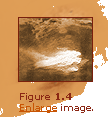|
|

Dust Storms
|
Besides clouds, another interesting dynamic feature within the
Martian atmosphere are dust storms. Martian dust storms are thought
to occur every Martian year and begin in the southern hemisphere
during the summer. During the southern spring, many small local
storms can be seen in areas where high winds develop. The picture
on the right shows a local storm near the South Polar Region (Figure
1.4). This dust storm was several hundred kilometers across. The
storm was created when the frost particles on the ground were lifted
into the atmosphere by the polar high winds. The more dust in the
atmosphere, the more quickly the atmosphere heated up during the
day, resulting in an increased temperature difference between day
and night in the upper atmosphere. The increasing temperature differences
in turn produced large winds that picked up more dust particles
such that the storms fed on themselves and spread rapidly over the
planet.
|
 |
 |
 |
 |
Prior to the Viking missions, each dust storm season was thought
to be much the same. However, the year when Viking landed on Mars,
two full-scale dust storms were detected. The following year, dust
storms turned out to be very mild and never reached a global scale.
In figure 1.5 the southern hemisphere was completely engulfed in
a north-spreading dust storm. How long can global dust storms last?
It is thought that a global dust storm will end when so much dust
is in the atmosphere that sunlight is blocked out, causing surface
temperatures to fall. Wind speeds would then drop and dust would
settle out from the air. It usually takes about three months for
the atmosphere to become clear again. Recent observations by the
Martian Global Surveyor confirm that global dust storms on Mars
remain an active geological process on the planet.
|
More recent
pictures of Martian atmospheric features obtained by the Martian Global
Surveyor are available on NASA's site.
< back
1 2
3 4
5 6
7 next
> |



